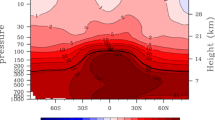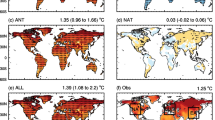Abstract
This study provides a comprehensive global analysis of the climate radiative feedbacks and the adjusted radiative forcing for a CO2 increase perturbation in the CNRM-CM5 climate model using the partial radiative perturbations (PRP) method. Some methodological key points of the PRP are investigated, with a particular focus on the consideration of the effect of fast adjustments. First, the standard PRP method is applied by neglecting certain fast adjustments. The effect of the field decorrelation is highlighted by performing a PRP across two different periods of a control experiment and by analyzing second-order terms. Sensitivity tests to the field substitution frequency, the sampling period and the perturbed experiment used are performed. The impact of the definition of the top of the climate system (top-of-the-atmosphere or tropopause) in the feedback estimate is also discussed. Secondly, the fast adjustment processes are taken into account by combining the PRP framework with the method of linear regression of the partial net radiative flux change against the mean surface air temperature change using a step forcing experiment. This method allows us to quantify the contribution of the different constituents to the forcing adjustment and to improve the estimation of the radiative feedbacks. It is shown that such decomposition allows the retrieval of the adjusted radiative forcing, the radiative feedbacks and the climate sensitivity as estimated with the linear regression method with a high level of accuracy, validating the partial decomposition.



Similar content being viewed by others
References
Bony S et al (2006) How well do we understand and evaluate climate change feedback processes? J Clim 19:3445–3482
Cess RD et al (1996) Cloud feedback in atmospheric general circulation models: an update. J Geophys Res 101:12791–12794
Colman RA, McAvaney BJ (1997) A study of GCM climate feedbacks from perturbed SST experiments. J Geophys Res 102:19383–19402
Colman RA (2003) A Comparison of climate feedbacks in general circulation models. Clim Dyn 20:865–873
Colman RA, McAvaney BJ (2011) On tropospheric adjustment to forcing and climate feedbacks. Clim Dyn 36:1649–1658
Crook JA, Forster PM, Stuber N (2011) Spatial patterns of modeled climate feedback and contributions to temperature response and polar amplification. J Clim 24:3575–3592
Dufresne J-L, Bony S (2008) An assessment of the primary sources of spread of global warming estimates from coupled atmosphere-ocean models. J Atmos Sci 21:5135–5144
Geoffroy O, Saint-Martin D, Ribes A (2012) Quantifying the sources of spread in climate change experiments. Geophys Res Lett 39:L24703 doi:10.1029/2012GL054172
Geoffroy O, Saint-Martin D, Bellon G, Voldoire A, Olivié DJL, Tytéca S (2013) Transient climate response in a two-layer energy-balance model. Part II: representation of the efficacy of deep-ocean heat uptake and validation for CMIP5 AOGCMs. J Clim 26:1859–1876
Gregory J, Webb M (2008) Tropospheric adjustment induces a cloud component in CO2 forcing. J Clim 21:58–71
Gregory JM et al (2004) A new method for diagnosing radiative forcing and climate sensitivity. Geophys Res Lett 31:L03205 doi:10.1029/2003GL018747
Hansen J, Lacis A, Rind D, Russell G, Stone P, Fung I, Ruedy R, Lemer J (1984) Climate sensitivity: analysis of feedback mechanisms. Climate processes and climate sensitivity (eds) American Geophysical Union, Washington, DC, pp 130–163
Hansen J, Sato M, Ruedy R (1997) Radiative forcing and climate response. J Geophys Res 102:6831–6864
Held IM, Shell KM (2012) Using relative humidity as a state variable in climate feedback analysis. J Clim 25:2578–2582
Knutti R, Hegerl GC (2008) The equilibrium sensitivity of the Earth’s temperature to radiation changes. Nat Geosci 1:735–743
Lal M, V Ramanathan (1984) The effects of moist convection and water vapor radiative processes on climate sensitivity. J Atmos Sci 41:2238–2249
Li C, von Storch J-S, Marotzke J (2012) Deep-ocean heat uptake and equilibrium climate response. Clim Dyn. doi:10.1007/s00382-012-1350-z
Schlesinger ME (1988) Quantitative analysis of feedbacks in climate model simulations of CO2-induced warming. Physically based modelling and simulation of climate and climatic change: part 2. In: Schlesinger ME (ed) NATO ASI Series C: mathematical and physical sciences, vol 243. Kluwer Academic Publishers, Berlin, pp 653–735
Schneider EK, Kirtman BP, Lindzen RS (1999) Tropospheric water vapor and climate sensitivity. J Atmos Sci 56:1649–1658
Senior CA, Mitchell JFB (2000) The time dependence of climate sensitivity. Geophys Res Lett 27:2685–2688
Soden BJ, Held IM (2006) An assessment of climate feedbacks in coupled ocean-atmosphere models. J Clim 19:3354–3360
Soden BJ, Held IM, Colman RA, Shell KM, Kiehl JT, Shields CA (2008) Quantifying climate feedbacks using radiative kernels. J Clim 21:3504–3520
Stein U, Alpert P (1993) Factor separation in numerical simulations. J Atmos Sci 50:2107–2115
Tomassini L, Geoffroy O, Dufresne J-L, Idelkadi A, Cagnazzo C, Block K, Mauritsen T, Giorgetta M, Quaas J (2013) The respective roles of surface temperature driven feedbacks and tropospheric adjustment to CO2 in CMIP5 transient climate simulations. Clim Dyn. doi:10.1007/s00382-013-1682-3
Voldoire A et al (2012) The CNRM-CM5.1 global climate model: description and basic evaluation. Clim Dyn. doi:10.1007/s00382-011-1259
Wetherald RT, Manabe S (1988) Cloud feedback processes in a general circulation model. J Atmos Sci 45:1397–1415
Winton M (2006) Surface albedo feedback estimates for the AR4 climate models. J Clim 19:359–365
Winton M, Takahashi K, Held IM (2010) Importance of ocean heat uptake efficacy to transient climate change. J Clim 23:2333–2344
Yoshimori M, Broccoli AJ (2008) Equilibrium response of an atmospheremixed layer ocean model to different radiative forcing agents: global and zonal mean response. J Clim 21:4399–4423
Zhang MH, Hack JJ, Kiehl JT, Cess RD (1994) Diagnostic study of climate feedback processes in atmospheric general circulation models. J Geophys Res 99:5525–5537
Acknowledgments
We gratefully thank the two anonymous reviewers for their comments that helped us to improve the manuscript. We also thank Hervé Douville and Lorenzo Tomassini for discussions. This work was supported by the European Union FP7 Integrated Project COMBINE.
Author information
Authors and Affiliations
Corresponding author
Rights and permissions
About this article
Cite this article
Geoffroy, O., Saint-Martin, D., Voldoire, A. et al. Adjusted radiative forcing and global radiative feedbacks in CNRM-CM5, a closure of the partial decomposition. Clim Dyn 42, 1807–1818 (2014). https://doi.org/10.1007/s00382-013-1741-9
Received:
Accepted:
Published:
Issue Date:
DOI: https://doi.org/10.1007/s00382-013-1741-9




